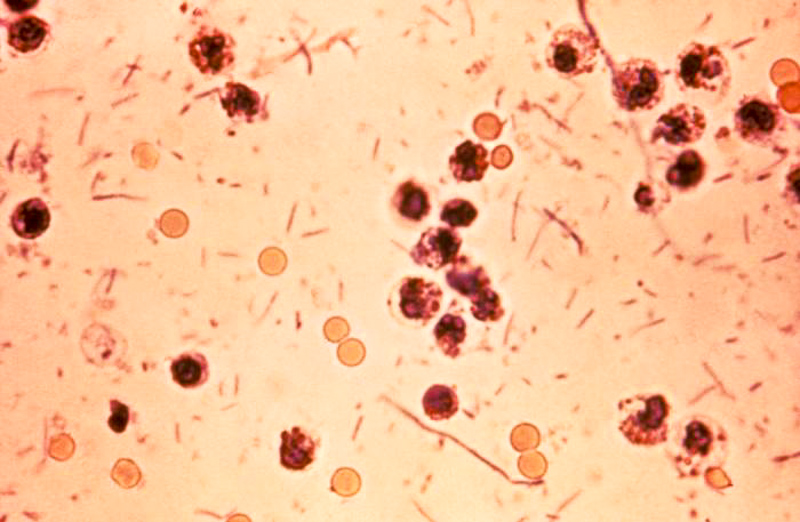Definition of 이질균 in the Korean dictionary
There are no gram negative bacilli (negative bacillus), apo (spore), and capsule (capsule) of 0.4 ~ 0.6 × 1.0 ~ 3.0um. It grows well in agar medium (agar medium) usually in anaerobic condition. Diarrhea is caused by oral ingestion of food contaminated with this bacterium. The incubation period is 2 to 4 days, and diarrhea of the point cloud is discharged. It is classified as catarase-positive, oxytazic negative, fermentative degradation of sugar (sugar), gas ratio production, citrate negative, KCN negative, and group of A to D group by 0 antigen. There are many multidrug - resistant bacteria. 이질균 장내세균과에 속하며, 0.4~0.6×1.0~3.0um의 그람음성간균(陰性杆菌), 아포(芽胞), 협막(莢膜)은 없다. 통성혐기성(通性嫌氣性)으로 보통 한천배지(寒天培地)에 잘 발육한다. 이 균에 오염된 식품의 경구섭취에 의하여 설사를 일으킨다. 잠복기는 2~4일간으로 점혈의 설사를 배출한다. 카타라제양성, 옥시타제음성, 당(糖)을 발효적으로 분해, 가스비생산, 구연산염음성, KCN음성, 0항원에 의하여 A~D군의 아군(亞群)으로 분류되고 있다. 다제내성균(多劑耐性菌)이 많이 존재한다.
Click to
see the original definition of «이질균» in the Korean dictionary.
Click to
see the automatic translation of the definition in English.
10 KOREAN BOOKS RELATING TO «이질균»
Discover the use of
이질균 in the following bibliographical selection. Books relating to
이질균 and brief extracts from same to provide context of its use in Korean literature.
요즘 흔히 사용하는 항생제를 이질균 속에 집어넣고, 다른 한쪽에는 활 성숯가루를 이질균 속에다 집어넣었습니다. 항생제를 넣은 이질균은 당연히 박멸될 것이지만, 활성 숯가루를 넣은 이질균은 어떻게 될지 알아보기 위한 실험이었습니다. 보름 만에 ...
2
Laboratory Diagnosis of Infectious Diseases: Essentials of ... - 310페이지
Genetically, Shigella spp. are virtually identical to E. coli. The four subgroups or serogroups (often referred to as species) of Shigella are • Shigella dysenteriae (subgroup/serogroup A), • Shigella flexneri (subgroup/serogroup B), • Shigella ...
Paul G. Engelkirk, Janet L. Duben-Engelkirk, 2008
3
Microbiology of Waterborne Diseases: Microbiological ... - 189페이지
Humans are the only important reservoir of Shigella. Excretion of Shigella in stools is highest during the acute phase of dysenteric illness. During this phase the environment is contaminated and the organisms can survive for weeks in cool and ...
Martha Embrey, Paul Hunter, Jane Sellwood, 2004
4
The Prokaryotes: Vol. 6: Proteobacteria: Gamma Subclass - 113페이지
Shigella species appear biochemically very similar, and differentiation among species depends on serological methods. In practice, serological methods using group- and type-specific antisera must be performed only after biochemical ...
Stanley Falkow, Eugene Rosenberg, Karl-Heinz Schleifer, 2006
5
Foodborne Microbial Pathogens: Mechanisms and Pathogenesis
Shigella was first discovered in 1896 by a Japanese microbiologist, Kiyoshi Shiga, who was investigating an outbreak of sekiri (means “dysentery” in Japanese). He isolated a bacillus from stool sample and called it Bacillus dysenteriae, now it ...
6
International Handbook of Foodborne Pathogens - 170페이지
V. ISOLATION AND IDENTIFICATION A. Biochemical Techniques Foods are not routinely examined for the presence of Shigella unless epidemiological data suggest they may be a source of an outbreak. Vegetables and salads are commonly ...
Marianne D. Miliotis, Jeffrey W. Bier, 2003
7
Foodborne Pathogens: Microbiology and Molecular Biology - 350페이지
Understanding the dynamics of the aforementioned factors, either as individual or collective components, may provide a more in-depth insight as to the affect that these environmental parameters have on the number of Shigella spp. present in ...
Pina M. Fratamico, Arun K. Bhunia, James L. Smith, 2005
8
Travelers' Diarrhea - 62페이지
Group C: Shigella boydii (18 serotypes) • Group D: Shigella sonnei (1 serotype) In developing countries, Shigella flexneri and Shigella dysenteriae type 1 are the predominant species causing diarrhea, whereas in developed countries, ...
Charles D. Ericsson, Herbert L. DuPont, Robert Steffen, 2007
9
Molecular Detection of Human Bacterial Pathogens - 1061페이지
d'Hauteville, H. et al., Lack of cleavage of IcsA in Shigella flexneri causes aberrant movement and allows demonstration of a cross-reactive eukaryotic protein, Infect. Immun., 64, 511, 1996. Egile, C. et al., SopA, the outer membrane protease ...
10
Molecular Medical Microbiology, Three-Volume Set - 1165페이지
Ogawa M, Suzuki T, Tatsuno I, Abe H, Sasakawa C. IcsB, secreted via the type III secretion system, is chaperoned by IpgA and required at the post-invasion stage of Shigella pathogenicity. Mol Microbiol 2003;48:913À31. Page AL, Sansonetti ...
Yi-Wei Tang, Max Sussman, Dongyou Liu, 2014


